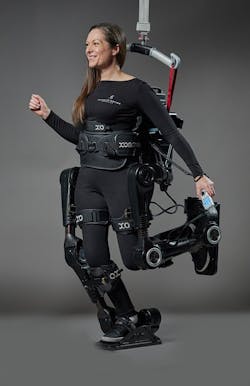Smarter Pills, Robot Legs & AI Guides: Check Out 3 Life-Changing Medical Inventions
In writing these blogs, I've come across a lot of medical innovations. I've reported on drug-release bandages, 3D printing for cranial skull replacements, hair transplant robots, and others. And today, I'd like to introduce you to three more medical innovations that continue to show how far the human race has progressed, especially compared to decades ago, not to mention the centuries past. We'll look at the PillSafe Smart Pill Bottle's approach to medication management, the robotic capabilities of the XoMotion exoskeleton, and the sensor fusion within the WeWALK Smart Cane 2. These pieces show just how versatile and impactful modern engineering can be.
PillSafe Smart Pill Bottle
How many of you have done the "Did I take my meds today?" dance? Or worse, the "dump-out-and-count" maneuver when you really can't remember? Yeah, me too. It's a daily struggle for lots of folks, and honestly, sometimes I feel like my pill bottle is mocking me.
Well, there's a new gadget that's trying to solve this exact headache: the PillSafe Smart Pill Bottle. PillSafe isn't just a bottle—it's a timed dispenser. You (or rather, your doctor) set the schedule, and it releases the exact dose at the exact time. No more guesswork, no more accidental (or intended) double-dosing (or skipping). And to prevent tampering, it has a built-in electronic system that activated what the company calls a "Fail-Safe Security Net".
The bottle sounds pretty secure too, with a tamper-proof cap, patient-specific access codes for the dispenser, and the electronic pill counter that tells you how many pills are left. The time-release feature locks things down based on the prescription.
The main idea behind this invention is to combat the opioid crisis as well as some common issues with prescription drugs. It's a smart approach to a devastating problem. And while it definitely doesn't get to the root of the problem, it can certainly help.
And it wouldn't be smart without wireless alerts. Real-time updates can go to both the patient (like a reminder) and the doctor. This keeps patients accountable and lets physicians track compliance. Now, my cynical side kicks in here...do doctors want alerts for every patient, every day? That sounds like notification overload waiting to happen, and most of the time, doctors leave you waiting; we don't need more of that. Maybe there's a dashboard view, or maybe that's a wrinkle they still need to iron out. Still, the potential for better oversight is definitely there.
Overall, I'm intrigued. While I have questions about the real-world implementation, the core idea of a smart, secure pill bottle that helps people stay on track and potentially saves lives (and billions of dollars) sounds like a genuinely useful innovation. What do you think? Could this finally be the pill bottle that helps us win the daily medication memory game?
XoMotion Medical Exoskeleton
You know, it's funny how things work. A few months ago, I was chatting with the CEO of HeroWear, the company that makes passive exosuits for workers, and I mentioned how it feels like exoskeletons have been pretty few and far between. And wouldn't you know it? Ever since I said that, it seems like new exoskeletons have been popping up more frequently. A couple of weeks ago, I wrote about the new Hypershell X hiking exoskeleton, and now we have the XoMotion.
This isn't just another clunky robot suit. Human in Motion Robotics (HMR) has built what they're calling the first self-balancing, hands-free medical exoskeleton.
It uses 12 actuators to mimic natural human walking and maintain stability all on its own. It can move in any direction and handle complex walking tasks. The goal is to help people with mobility issues, such as spinal cord injuries, stroke recovery, and other neurological conditions, regain more natural movement. Plus, it's designed to ease the physical burden on therapists who often have to do a lot of heavy lifting during rehab sessions.
The company recently got a prime spot showing off the XoMotion at the closing ceremonies of the Invictus Games 2025 in Vancouver & Whistler. If you're not familiar, the Invictus Games, founded by Prince Harry, the Duke of Sussex, is an international event for wounded, injured, and sick service members and veterans competing in adaptive sports.
And the person demonstrating it? HMR's Product Ambassador & Director of Lived Experience, Chloë Angus. After a medical event in 2015 led to permanent paralysis, she's been on a journey to find solutions beyond the usual therapies. Seeing her use the XoMotion (there's a video link below the original article if you want to check it out) drives home the potential impact of this tech. It's not just about engineering; it's about changing lives.
It seems others are noticing, too. USA Today called the XoMotion the top robot from CES 2025.
Right now, if you're a rehab or research facility in Canada, you can acquire one. They're working on FDA approval for the US market and have eyes on Europe and Asia, too. Researchers worldwide can also get their hands on it.
So yeah, maybe I spoke too soon about exoskeletons being slow to arrive. Between devices for industry, hiking, and now this advanced medical model, it does feel like they're gaining momentum. As more studies prove their benefits, I stand by my prediction: we're going to see these devices explode onto the market.
WeWALK Smart Cane 2
When you think about assistive technology, the white cane is pretty iconic. It's simple, effective, and has been helping visually impaired people navigate the world for generations. But like most things, technology is finding ways to make it even better. We've seen medical exoskeletons giving people mobility, and now, in that same innovative spirit, smart canes are stepping onto the scene.
The WeWALK Smart Cane 2 isn't just your standard cane with a gadget slapped on. It's packed with tech like motion sensors, microphones, and time-of-flight sensors (all from TDK) working together to provide navigation and detect obstacles in a way a traditional cane can't.
So, what does all that tech do? Imagine walking down the street and having your cane not only detect obstacles on the ground but also warn you about that low-hanging branch you might smack your head on. The WeWALK uses haptic feedback and sound alerts for exactly that, even including overhead hazards while still giving you the ground-level feel you expect from a cane.
It also has a built-in AI voice assistant so users can talk to their cane. Need the safest route home? Directions to the nearest coffee shop? Wondering what cool points of interest you're passing? Just ask. It uses built-in speakers for audio responses, and it can even make calls.
It connects to smartphones via Bluetooth, which means phones can be safely tucked away while getting turn-by-turn navigation. They've integrated Moovit for transit info too, so users can check bus schedules and navigate to stops right from the cane. It seems like they've really thought about creating a seamless travel experience, offering different navigation modes like clock directions and low-vision mapping.
Now, there is a catch. The voice assistant requires a subscription. The good news is, it's not crazy expensive ($4.99/month). The other current limitation is that the voice assistant only speaks English.
Despite the subscription and language limit, I have to say, the WeWALK Smart Cane 2 looks like a seriously impressive piece of tech. It takes a familiar tool and layers on features that could genuinely enhance safety, independence, and exploration for visually impaired individuals. It's another cool example of how smart sensors and AI are being used to solve real-world challenges.
Fun Innovations Friday
Created by the editors of New Equipment Digest and Plant Services, Fun Innovations Friday is a feel-good blog that showcases how advances in science, math, engineering, and technology are making our world more whimsical. Here's another post that's guaranteed to brighten your day.
Meet Disney's Real-Life Wall-E: An Autonomous Robot That Learns Social Cues
Disney is bringing the idea of a real-life Wall-E closer to reality with its new robot that learns social skills using AI mimicry instead of just programming.
About the Author
Laura Davis
Editor-in-Chief, New Equipment Digest
Laura Davis is the editor in chief of New Equipment Digest (NED), a brand part of the Manufacturing Group at EndeavorB2B. NED covers all products, equipment, solutions, and technology related to the broad scope of manufacturing, from mops and buckets to robots and automation. Laura has been a manufacturing product writer for eight years, knowledgeable about the ins and outs of the industry, along with what readers are looking for when wanting to learn about the latest products on the market.



